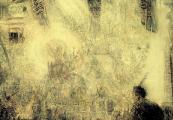This archived website ‘James Ensor. An online museum.’ is temporarily not being updated. Certain functionality (e.g. specific searches in the collection) may no longer be available. News updates about James Ensor will appear on vlaamsekunstcollectie.be. Questions about this website? Please contact us at info@vlaamsekunstcollectie.be.
Ensor as Draftsman
Few artists have attributed such meaning to drawing as James Ensor. Painting and drawing are on the same level for him. Among other things, this seems to be apparent from the fact that Ensor also entered drawings for exhibitions as legitimate works of art. Some of his drawings are executed on a large format so that they could further compete with the paintings.
As a young artist, Ensor usually used gaphite or black chalk to render his direct surroundings as image. He filled sketchbooks with portraits and fragments of his interior. Drawings after nature are rather rare.
During the years 1885-1887, when his art took a new turn and the fantastic and satirical entered the picture, it appears that even then the artist gave preference to drawing over painting. He created the great The Aureoles of Christ or The Sensibilities of Light (1885-1886) in which he depicted a mass of figures under a supernatural light. The Aureoles of Christ consists of six drawings. Two works are in the Museum of Fine Arts Ghent and two are preserved in the Royal Museum of Fine Arts of Belgium in Brussels. The other drawings are in private possession (in Belgium and the United Kingdom).
In addition, Ensor drew various motifs, which he grouped under the titles ̳fantasies and grotesques‘. During this period, Ensor also had the peculiar habit of drawing over older, realistic sketches in order to transform them into surreal compositions. The coda of this drawing adventure is a curious collage of 71 drawings assembled together in a bizarre representation of The Temptation of St. Anthony (1887, mixed technique, Chicago, The Art Institute).
In his small and large drawings from the period 1885-1890, Ensor developed a personal style to suggest light effects with shading and a fine pattern of lines. As seen from the line pattern, the typical arabesques and graphic fantasies are already present on paper, that we also encounter in Ensor‘s paintings from ca. 1887 onwards. After 1890, the drawing is less prevalent in Ensor‘s oeuvre. The later drawings are often executed in colour, by which they sometimes resemble small paintings. Worth noting is that Ensor‘s oil paintings from the same period also take on a more graphic character for their part.
Robert Hoozee














